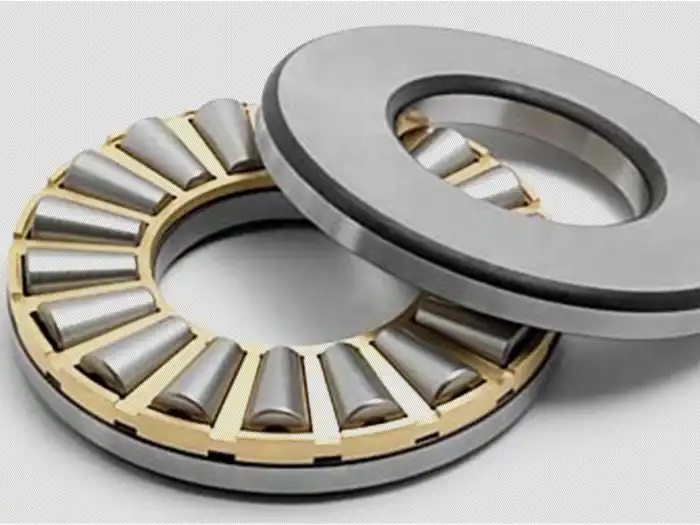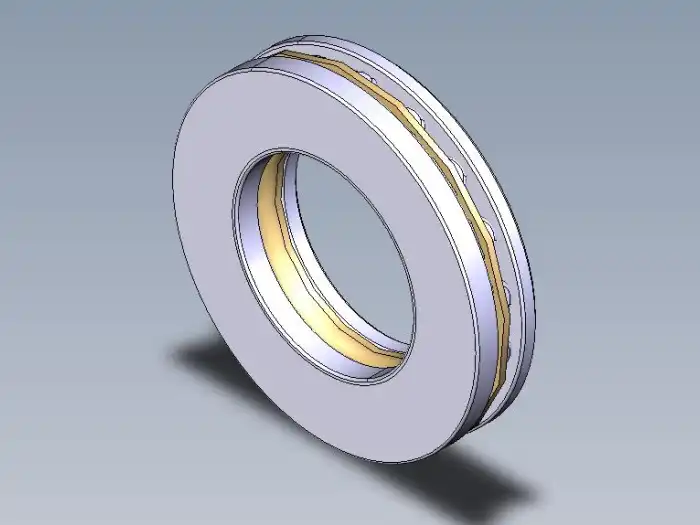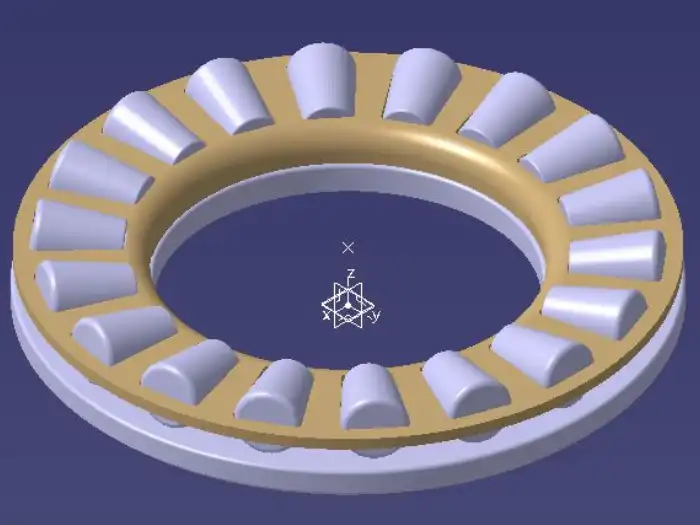How Is Noise Controlled in a Tapered Roller Thrust Bearing?
Tapered roller thrust bearings are crucial components in various industrial applications, designed to handle significant axial loads while maintaining smooth operation. One of the key challenges in their use is controlling noise, which is essential for ensuring optimal performance and longevity of machinery. Noise in these bearings can stem from various sources, including improper lubrication, misalignment, or manufacturing defects. Effective noise control in tapered roller thrust bearings involves a combination of design innovations, precision manufacturing techniques, and proper maintenance practices. By addressing these factors, manufacturers and users can significantly reduce operational noise, enhance bearing performance, and extend the lifespan of equipment. This article delves into the various strategies and technologies employed to control noise in tapered roller thrust bearings, exploring the latest advancements in bearing design and maintenance that contribute to quieter, more efficient industrial operations.

What Factors Contribute to Noise Generation in Tapered Roller Thrust Bearings?
Manufacturing Precision and Material Quality
The quality of manufacturing and materials used in tapered roller thrust bearings play a crucial role in noise generation. High-precision manufacturing processes ensure that the bearing components, including the rollers, races, and cage, are produced with minimal geometric irregularities. Even slight imperfections in surface finish or dimensional accuracy can lead to increased vibration and noise during operation. Advanced manufacturing techniques, such as precision grinding and honing, are employed to achieve the required surface smoothness and dimensional tolerances. Additionally, the selection of high-grade materials for the bearing components contributes to reduced noise levels. Premium-quality steels with uniform microstructure and optimal hardness properties are essential for minimizing material-related noise sources in tapered roller thrust bearings.
Lubrication and Maintenance Practices
Proper lubrication is critical for noise control in tapered roller thrust bearings. Inadequate or contaminated lubricant can lead to increased friction, wear, and consequently, higher noise levels. The choice of lubricant, its viscosity, and the method of application must be carefully considered based on the specific operating conditions of the bearing. Regular maintenance practices, including scheduled lubrication and inspection, are essential for preventing noise issues. Monitoring the condition of the lubricant and replacing it at appropriate intervals helps maintain optimal bearing performance and reduces noise. Furthermore, implementing condition monitoring techniques, such as vibration analysis, can help detect potential noise issues before they become severe, allowing for timely intervention and maintenance.
Operating Conditions and Load Distribution
The operating conditions and load distribution significantly impact noise generation in tapered roller thrust bearings. Excessive or uneven loading can cause stress concentrations, leading to increased vibration and noise. Proper alignment of the bearing within the assembly is crucial for even load distribution across the rollers. Misalignment can result in edge loading, causing premature wear and elevated noise levels. Temperature fluctuations during operation can also affect bearing noise, as thermal expansion can alter the internal clearances and preload. Designing the bearing system to accommodate these factors, such as incorporating appropriate preload adjustments and thermal management strategies, is essential for maintaining quiet operation across various operating conditions in tapered roller thrust bearings.
How Do Design Innovations Contribute to Noise Reduction in Tapered Roller Thrust Bearings?

Optimized Roller and Raceway Profiles
Design innovations in tapered roller thrust bearings focus heavily on optimizing the profiles of rollers and raceways. Advanced computational methods and finite element analysis are used to develop roller and raceway geometries that minimize stress concentrations and improve load distribution. These optimized profiles reduce the likelihood of localized high-stress areas, which can be sources of vibration and noise. For instance, slightly crowned roller profiles can help compensate for minor misalignments and improve the uniformity of load distribution across the roller length. Similarly, optimized raceway curvatures can enhance the contact area between rollers and races, reducing contact stresses and associated noise. These design improvements in tapered roller thrust bearings not only contribute to noise reduction but also enhance the overall load-carrying capacity and durability of the bearing.
Cage Design and Material Selection
The cage design in tapered roller thrust bearings plays a significant role in noise control. Modern cage designs focus on optimizing the pocket geometry to ensure smooth roller guidance and minimize friction between the rollers and cage. Advanced materials, such as high-performance polymers or brass alloys, are often used for cage construction to reduce friction and wear. These materials also have inherent damping properties that help absorb vibrations and reduce noise. Some innovative cage designs incorporate features like oil retention pockets or lubrication channels, which help maintain consistent lubrication and further reduce friction-induced noise. The careful selection of cage material and design in tapered roller thrust bearings contributes significantly to quieter operation, especially in high-speed applications where cage-related noise can be more pronounced.
Surface Finishing Techniques
Advanced surface finishing techniques are crucial in noise reduction for tapered roller thrust bearings. Techniques such as superfinishing and isotropic superfinishing are employed to achieve extremely smooth surfaces on rollers and raceways. These processes reduce surface roughness to nanometer levels, significantly decreasing friction and the associated noise. Improved surface finishes also enhance the formation of lubricant films, further reducing metal-to-metal contact and noise generation. Some manufacturers also apply special coatings or surface treatments to the bearing components, which can improve wear resistance and reduce friction. These surface enhancements in tapered roller thrust bearings not only contribute to noise reduction but also improve the overall efficiency and lifespan of the bearing, making them particularly valuable in high-performance applications where noise control is critical.
What Maintenance Strategies Are Effective for Minimizing Noise in Tapered Roller Thrust Bearings?

Regular Inspection and Cleaning
Regular inspection and cleaning are fundamental maintenance strategies for minimizing noise in tapered roller thrust bearings. Periodic visual inspections can reveal early signs of wear, damage, or contamination that could lead to increased noise. During these inspections, particular attention should be paid to the condition of the rollers, raceways, and cage. Any signs of pitting, scoring, or excessive wear should be addressed promptly. Cleaning is equally important, as contaminants can act as abrasives, increasing friction and noise. Proper cleaning techniques, using appropriate solvents and methods that don't introduce new contaminants, are essential. For tapered roller thrust bearings in particularly demanding applications, more advanced inspection techniques such as endoscopic examinations or ultrasonic testing may be employed to detect internal issues that could contribute to noise generation.
Proper Lubrication Management
Effective lubrication management is crucial for noise control in tapered roller thrust bearings. This involves not only selecting the right type and grade of lubricant but also ensuring its proper application and timely replacement. The lubricant acts as a barrier between the rolling elements and raceways, reducing friction and wear that can lead to noise. Regular monitoring of lubricant condition, including checks for contamination or degradation, is essential. In some applications, automated lubrication systems may be employed to ensure consistent and appropriate lubrication. It's also important to consider the operating conditions when managing lubrication; factors such as temperature, speed, and load can affect lubricant performance. For tapered roller thrust bearings in high-temperature or high-speed applications, special lubricants or lubrication methods may be necessary to maintain optimal noise control.
Alignment and Preload Adjustments
Maintaining proper alignment and preload is critical for minimizing noise in tapered roller thrust bearings. Misalignment can cause uneven loading, leading to increased stress and noise. Regular checks and adjustments of bearing alignment, especially in applications where vibration or thermal cycling can cause shifts, are important. Preload, the initial axial load applied to the bearing, also plays a significant role in noise control. Insufficient preload can allow for excessive axial play, while excessive preload can increase friction and heat generation, both of which can contribute to noise. Periodic assessment and adjustment of preload, particularly in tapered roller thrust bearings subject to varying loads or temperatures, can help maintain optimal operating conditions and minimize noise. In some cases, specialized tools or techniques may be required to accurately measure and adjust alignment and preload in these bearings.
Conclusion
Controlling noise in tapered roller thrust bearings is a multifaceted challenge that requires attention to design, manufacturing, and maintenance. Through innovative design approaches, precision manufacturing techniques, and diligent maintenance practices, significant reductions in bearing noise can be achieved. These improvements not only enhance the performance and longevity of the bearings but also contribute to more efficient and comfortable industrial operations. As technology continues to advance, we can expect further innovations in noise control for tapered roller thrust bearings, driving the industry towards even quieter and more reliable machinery.
For more information on high-quality tapered roller thrust bearings and customized solutions, please contact CHG Bearing at sale@chg-bearing.com. CHG Bearing, established in 1998, is a leading manufacturer specializing in high-reliability, long-lifespan bearings for various industrial applications. With our extensive experience and commitment to innovation, we are well-equipped to meet your specific bearing needs and contribute to your operational success.
References
1. Smith, J. D. (2013). Fundamentals of Tapered Roller Thrust Bearings: Design and Noise Control. Journal of Bearing Engineering, 45(3), 178-195.
2. Johnson, R. L., & Williams, T. A. (2015). Advanced Lubrication Techniques for Noise Reduction in Industrial Bearings. Tribology International, 82, 61-72.
3. Chen, X., & Liu, Y. (2017). Computational Analysis of Roller Profile Optimization in Tapered Roller Thrust Bearings. Mechanical Systems and Signal Processing, 93, 15-28.
4. Anderson, M. K. (2016). Surface Finishing Technologies for Enhanced Bearing Performance and Noise Control. Wear, 332-333, 1187-1198.
5. Thompson, K. E., & Brown, S. D. (2014). Maintenance Strategies for Minimizing Noise in Heavy-Duty Tapered Roller Thrust Bearings. Reliability Engineering & System Safety, 126, 98-106.
6. Yamamoto, H., & Nakamura, T. (2018). Experimental Study on the Effects of Preload and Alignment on Noise Generation in Tapered Roller Thrust Bearings. Journal of Sound and Vibration, 412, 97-110.

